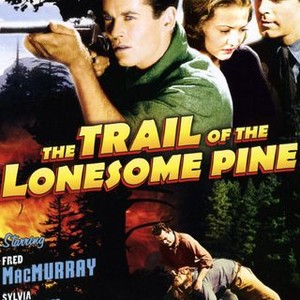
Because of their saturation, the various colours are able to converge organically and contribute perfectly harmonized texture and visual interest to the shot without departing from a subdued design.įrames from The Trail of the Lonesome Pine. As such, hard colour contrasts are rejected in favour of a mixture of neutral (gray and beige) with analogous hues (red-rose and brown) of roughly constant saturation and subtly graduated brightness. The film's design also combines details of flat, unsaturated colours to produce a varied - though neutralized - background for action. Dominated by cabin interiors and woodland, the setting of Hathaway's picture is generally rendered in shades and tones of brown and gray when other hues are present (mostly in green foliage and blue sky) they often possess a pronounced gray undertone. Whereas Becky Sharp indulged in highlights against a neutral background, The Trail of the Lonesome Pine deliberately avoided using accents, instead varying the neurals to create a more complex texture. The use of subdued colours made the scenes look more like real life. One of the top five highest-grossing pictures of the year, The Trail of the Lonesome Pine served as the model for a brief cycle of colour «ecology dramas,» including 20th Century Fox's Ramona (1936) and Warner Bros.' God Is Where You Find It (1938).įrames of The Trail of the Lonesome Pine, showing the characters wearing mostly gray clothes.

Dave eventually sacrifices his own life to end the violence between the families, opening the way for June to marry Jack, who has by now turned her into the sophisticated lady that she had always wanted to be.

This romantic entanglement is complicated by a feud between the Tollivers and the Fallins, who inadvertently kill June's little brother Buddie (George «Spanky» MacFarland) in a bombing at his construction site. Based on John Fox Jr.'s eponymous 1908 novel, this Paramount release centers on a love triangle between coal-company engineer Jack Hale (Fred MacMurray), wild country girl June Tolliver (Sylvia Sidney), and her fiancé and cousin, Dave Tolliver (Henry Fonda). The landmark film in the restrained mode was Henry Hathaway's The Trail of Lonesome Pine (1936), which was also the first three-strip Technicolor feature to be shot on an outdoor location. The final stage in Process IV consisted of bringing the matrices for each strip into high-pressure contact with the receiver, which imbibed and held the dyes, thus rendering a wider spectrum of colour than previous technologies. Since this was also a subtractive system, the dyes were complementary to the colour of light recorded by the negative printed on it: cyan for red, magenta for green and yellow for blue. The three negatives were printed onto the corresponding matrices (one for each colour), which were then developed, bleached and washed to form reliefs that could absorb the dyes for the imbibition process. Using a special dichroic beam-splitter equipped with two 45-degree prisms in the form of a cube, light from the lens was deflected by the prisms and split into two paths to expose each one of three black-and-white negatives (one each to record the densites of red, green and blue). In response to the sudden decline in colour films, Kalmus and his associates introduced the Technicolor Process Number IV, which, unlike its predecessors, recorded all three primary hues. Since dye imbibition was not suitable for printing optical soundtracks, which required very high resolution, the blank stock used for sound-on-film system was a conventional black-and-white stock on which the soundtrack, as well as the frame lines, had been printed in the regular way prior to the dye transfer operation. The two strips would then come into direct contact in a machine that used pressurized rollers to emboss the dyes in colours nominally complementary to those of the camera filters into a single print, thus eliminating some of the problems that had become evident with the double-cementing method. This technique involved the coating of a normal thickness 35mm matrix with the appropriate dye and its subsequent transfer onto a special blank stock.


The two strip negatives were exposed in the same fashion as in the previous cement method, only this time the two images were printed on the side of the positive through the incorporation of dye imbibition. A crucial step in the Technicolor system was taken in 1928 with the introduction of dye-transfer printing, known as Technicolor Process Number Three.


 0 kommentar(er)
0 kommentar(er)
